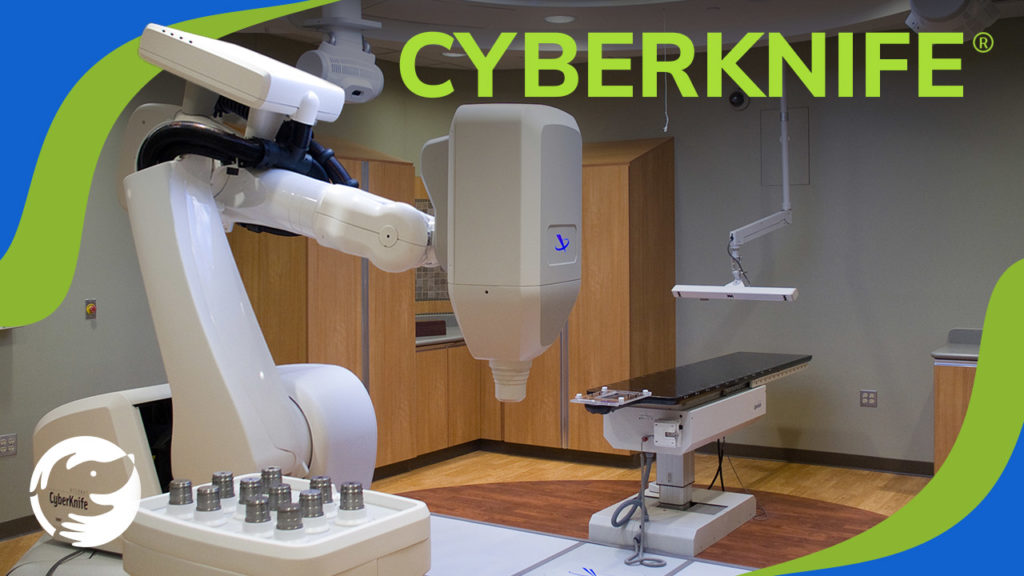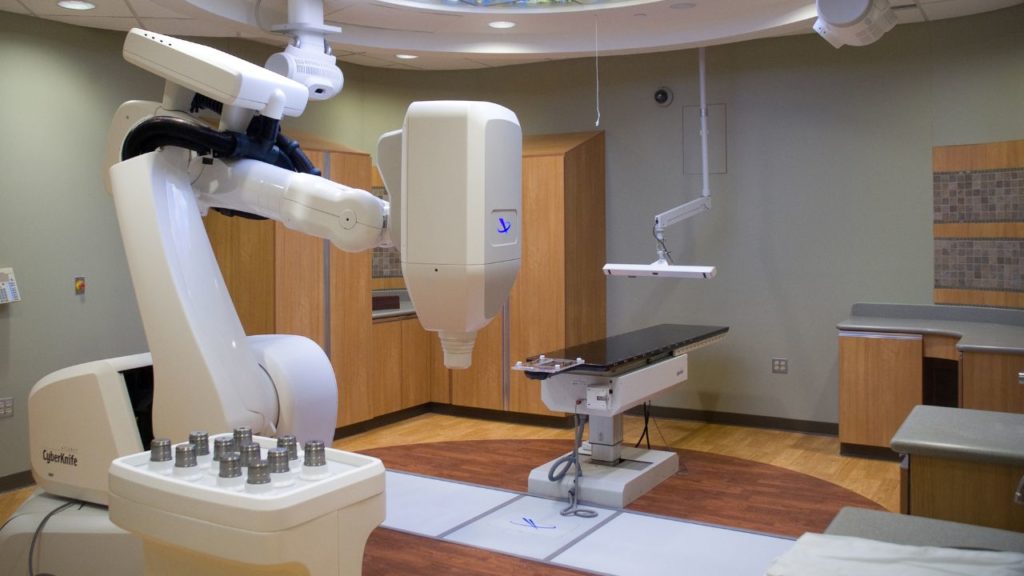
Cyberknife – Cutting Edge Technology
Dr. Ettinger shares her experiences with the Cyberknife in brain and nasal cancer and explains how it differs from traditional radiation.
James Jacobson: One of the interesting things is seeing how human medicine is applying to veterinary medicine and the technology is constantly changing. One of the tools that’s use increasingly in human cancer treatment is to be called the cyberknife. Dr. Ettinger you know a little about that because you’re using that in the veterinary medicine at your hospital in New York. Tell us about that.
Dr. Susan Ettinger: The cyberknife is a type of unit for type of treatment called radio surgery which is a little bit of a confusing name for most people cause there’s no surgery involved but actually we’re using the radiation beam in place of surgery. One of the big requirements for a dog or a cat to be treated with cyberknife radio surgery is that they actually have measurable tumor. It’s not gonna be good for your dog if they have a surgical scar that was determined to have incomplete margins or tumor cells left at the surgical scar. In general, we’re using it for non-surgical cancers. The number one type of tumor that we’re treating is brain surgery so you can imagine a lot of dogs with brain cancer there in parts of the brain that are not very accessible when they have a measurable tumor in that area. The second most common type of tumor that we’re treating with the radio surgery with the cyberknife unit is nasal cancers. We’ve treated over about two hundred and fifty dogs to date, we’ve been treating dogs for about three years here, uh, and we…
James Jacobson: Your one of the only places in America where you’re using a cyberknife on animals, right?
Dr. Susan Ettinger: Yeah, I think we’re, there may be another place that’s using one, Colorado State University has a different type of radio surgery unit, but there may be one other place out there at this point, but when we first open, we were the first place to be using cyberknife radio surgery.
James Jacobson: So this is still pretty cutting-edge…
Dr. Susan Ettinger: This is very cutting-edge…
James Jacobson: So pun intended, which cancers again are the best candidates for cyberknife?
Dr. Susan Ettinger: I have to say that hands down brain cancer, cyberknife is the treatment of choice for brain cancer. For these non-surgical brain cancer patients, the advantage of cyberknife is that we can treat their tumor in one to three treatments. If it’s three treatments it’s done in consecutive days. The alternative is fifteen to twenty treatments with daily anaesthesia which is required for dogs for radiation therapy. Again, one of the other differences besides decreased number of treatments again one to three decreased numbers of anaesthesia, decreased number of trips to the hospital; is also we’re getting less side effects and the main difference with cyberknife radio surgery in conventional or traditional radiation therapy is our type of radiation that’s very conforming to the type of the tumor. So we treat within sub-millimeter accuracy around the tumor and we do not….
James Jacobson: Meaning, very, very small, very precise.
Dr. Susan Ettinger: Very precise treatment and we get very little side effects from our treatment because we’re not treating much of the normal tissue if any that is just around the tumor. Again, that’s the huge difference between conventional radiation and the cyberknife radio surgery.
James Jacobson: Dr. Dressler, what do you think, you’re in Hawaii, obviously there are no cyberknifes in Hawaii, what do you think about this leading edge technology that’s being moved from humans to dogs?
Dr. Demian Dressler: Well, I think it’s great. I honestly believed that this is a prime example of getting rid of our biases. I have always advocated something I call full spectrum care and by full spectrum care, what we’re talking about is using any tool that can benefit our dogs. For us to be able to use any tool that can benefit our dogs, regardless of the color of the wrapping paper that is being delivered in, we need to get rid of our own biases. We see bias happening a lot in many different camps, say in conventional veterinary care, I come from a conventional veterinary care background, I’m a trained conventional veterinarian, graduated from Cornell University and I learned conventional veterinary care and practice conventional veterinary care.
James Jacobson: Both of you guys graduated from Cornell.
Dr. Demian Dressler: That’s right… Sue and I went to school together.
Dr. Susan Ettinger: We did…
Dr. Demian Dressler: A funny story… but anyway, back to what we’re talking about, the important thing for say a conventional veterinarian is to say, “Okay here we have a circumstance a brain tumor, nasal tumor something like that where we don’t have a lot of very successful option, so what we’re dealing in terms of success rate, it’s increasing survival times, it’s not really all that great, for most guardians and frankly for most veterinarians also”. So we need to search for other sources of information so that we can do better, we can do a better job and the cyberknife is an example of these. For example, there may be veterinarians out there who would call themselves holistic or alternative veterinarian or something like that and they’ve got bias there, where they may say, “Okay we don’t want to use antibiotics, we don’t want to use this tool”, and you as a guardian may lose access to something that may benefit your dog just like a conventional veterinarian may say, “Hey, I’m not gonna use acupuncture”, or meanwhile on places like the Mayo Clinic which are a huge cancer treatment centers for people they built acupuncture and is now a standard of care that’s part of proper treatment for cancer. So we need to avoid these biases when we’re contemplating high tech advances in the conventional front such as a cyberknife which by the way is very cool. I was out in New York recently, went up to Yonkers, went up to the animal specialty center, saw all the cyberknife the thing is amazing, and for the right case and the right guardian and the right type kind of cancer, the cyberknife would be something that we should be considering.
Dr. Susan Ettinger: Yeah, I mean we’ve actually treated dogs from Canada, we’ve treated dogs from couple weeks ago, we have some guardians drive in with their dog from Chicago, Virginia, Florida. So, one of the nice things because it’s so few treatments is that a lot of people will come into town for a week and we got the treatment done for them. It’s nice if they can travel lot of people will drive on in after giving us a call on making sure obviously that it’s the right case for cyberknifes…
James Jacobson: If it’s the right case, what’s an average ballpark figure for a cyberknife treatment?
Dr. Susan Ettinger: The cyberknife, including all of the imaging, we have to do CT Scans beforehand even if they’ve been done just because we have to do some markers for our machine for the planning. But in general, somewhere between 7500 and 8,000 dollars for the treatment. That includes all the imaging, all the anaesthesias.
James Jacobson: Okay, great. Dr. Ettinger in New York, Dr. Dressler in Hawaii, thank you so much.
Dr. Susan Ettinger: Thank you.
Dr. Demian Dressler: Thanks.
Topics
Did You Find This Helpful? Share It with Your Pack!
Use the buttons to share what you learned on social media, download a PDF, print this out, or email it to your veterinarian.
Editor's Picks
CATEGORY






